The Variation in Atmospheric Turbidity over a Tropical Site in Nigeria and Its Relation to Climate Drivers
Abstract
1. Introduction
2. Methodology
2.1. Study Site and Ground Data
2.2. Computation Methodology
2.2.1. The Linke Turbidity Coefficient
2.2.2. The Ångström Turbidity Coefficient
2.2.3. The Unsworth–Monteith Coefficient
2.2.4. The Schüepp Turbidity Coefficient
2.3. Selection of Clear-Sky Data
- The hours during which normal direct solar radiation falls below 200 W/m2 were disregarded to eliminate the early morning and near-sunset hours when diffuse radiation is prevalent.
- The ratio of daily diffuse radiation to daily incoming solar radiation on the horizontal plane should be 0.3 or less.
- The dataset with a cloud amount ≤ 0.1, a clearness index ≤ 0.13, and high air temperature between 30 and 38 °C was used for this study [86]. The cloud amount and the clearness index were determined using equations proposed by [97], Equations (S21) and (S22) in the Supplementary Materials [86].
2.4. Trajectory Modelling (HYSPLIT)
3. Results and Discussion
3.1. Variations in Aerosol Optical Depth
3.2. Seasonal Variability of the Atmospheric Turbidity
3.2.1. Daily Temporal and Monthly Variations in the Ångström Exponent and Turbidity Coefficients Estimated from the Measured AOD
3.2.2. Correlation between the Ångström Exponent and Turbidity Coefficients Estimated from the Measured AOD
3.2.3. Daily Temporal and Monthly Variations in Atmospheric Turbidity Coefficients
3.2.4. Frequency Distribution of Atmospheric Turbidity
3.3. Atmospheric Turbidity, Meteorological Parameters and Air Mass
3.3.1. Relationship between the Atmospheric Turbidity Coefficients and Wind Speed and Wind Direction
3.3.2. Atmospheric Turbidity, Relative Humidity, and Water Vapor Pressure
3.4. Atmospheric Turbidity and Air Mass Backward Trajectories
4. Conclusions
Supplementary Materials
Author Contributions
Funding
Institutional Review Board Statement
Informed Consent Statement
Data Availability Statement
Acknowledgments
Conflicts of Interest
References
- Iqbal, M. An Introduction to Solar Radiation; Academic Press: New York, NY, USA, 1983. [Google Scholar]
- Wild, M.; Gilgen, H.; Roesch, A.; Ohmura, A.; Long, C.N.; Dutton, E.G.; Forgan, B.; Kallis, A.; Russak, V.; Tsvetkov, A. From Dimming to Brightening: Decadal Changes in Solar Radiation at Earth’s Surface. Science 2005, 308, 847–850. [Google Scholar] [CrossRef]
- Wang, L.C.; Kisi, O.; Zounemat-Kermani, M.; Salazar, G.A.; Zhu, Z.; Gong, W. Solar Radiation Prediction Using Different Techniques: Model Evaluation and Comparison. Renew. Sustain. Energy Rev. 2016, 61, 384–397. [Google Scholar] [CrossRef]
- Wang, L.; Chen, Y.; Niu, Y.; Salazar, G.A.; Gong, W. Analysis of Atmospheric Turbidity in Clear Skies at Wuhan, Central China. J. Earth Sci. 2017, 28, 729–738. [Google Scholar] [CrossRef]
- Soneye, O.O.; Ayoola, M.A.; Ajao, I.A.; Jegede, O.O. Diurnal and seasonal variations of the incoming solar radiation flux at a tropical station, Ile-Ife, Nigeria. Heliyon 2019, 5, e01673. [Google Scholar] [CrossRef] [PubMed]
- El-Wakil, S.A.; El-Metwally, M.; Gueymard, C. Atmospheric turbidity of urban and desertic areas of the Nile basin in the aftermath of Mt. Pinatubo’s eruption. Theor. Appl. Climatol. 2001, 68, 89–108. [Google Scholar] [CrossRef]
- Kaskaoutis, D.; Kambezidis, H.; Jacovides, C.; Steven, M. Modification of solar radiation components under different atmospheric conditions in the greater Athens area, Greece. J. Atmos. Sol.-Terr. Phys. 2006, 68, 1043–1052. [Google Scholar] [CrossRef]
- Chaâbane, M. Analysis of the atmospheric turbidity levels at two Tunisian sites. Atmos. Res. 2008, 87, 136–146. [Google Scholar] [CrossRef]
- Kaskaoutis, D.; Kambezidis, H. The diffuse-to-globa land diffuse-to-direct-beam spectral irradiance ratios as turbidity indexes in an urban environment. J. Atmos. Sol.-Terr. Phys. 2009, 71, 246–256. [Google Scholar] [CrossRef]
- Gueymard, C. Clear-sky irradiance predictions for solar resource mapping and large-scale applications: Improved validation methodology and detailed performance analysis of 18 broadband radiative models. Sol. Energy 2012, 86, 2145–2169. [Google Scholar] [CrossRef]
- El-Metwally, M. Indirect determination of broadband turbidity coefficients over Egypt. Meteorol. Atmos. Phys. 2013, 119, 71–90. [Google Scholar] [CrossRef]
- Lin, A.W.; Zou, L.; Wang, L.; Gong, W.; Zhu, H. Estimation of Atmospheric Turbidity Coefficient over Zhengzhou during 1961–2013 using an improved hybrid model. Renew. Energy 2016, 86, 1134–1144. [Google Scholar] [CrossRef]
- Djelloul, D.; Abdanour, I.; Philippe, K.; Mohamed, Z.; Mustapha, M. Investigation of atmospheric turbidity at Ghadaa (Algeria) using both ground solar irradiance measurements and space data. Atmos. Clim. Sci. 2019, 9, 114–134. [Google Scholar] [CrossRef][Green Version]
- Zaiani, M.; Irbah, A.; Djafer, D.; Listowski, C.; Delanoe, J.; Kaskaoutis, D.; Boualit, S.B.; Chouireb, F.; Mimouni, M. Study of atmospheric turbidity in a Northern Tropical region using models and measurements of global solar radiation. Remote Sens. 2021, 13, 2271. [Google Scholar] [CrossRef]
- Garniwa, P.M.P.; Lee, H. Intercomparison of the parameterized Linke turbidity factor in deriving global horizontal irradiance. Renew. Energy 2023, 212, 285–298. [Google Scholar] [CrossRef]
- Hansen, V. Determination of atmospheric turbidity parameters from spectral radiance measurements. Arch. Meteor. Geophys. Bioklim. Ser. B 1974, 22, 301–308. [Google Scholar] [CrossRef]
- Trabelsi, A.; Masmoudi, M. An investigation of atmospheric turbidity over Kerkennah Island in Tunisia. Atmos. Res. 2011, 101, 22–30. [Google Scholar] [CrossRef]
- Ångström, A. Techniques of determining the turbidity of the atmosphere. Tellus 1961, 13, 214–223. [Google Scholar] [CrossRef]
- Li, D.H.W.; Lam, J.C. A Study of Atmospheric Turbidity for Hong Kong. Renew. Energy 2002, 25, 1–13. [Google Scholar] [CrossRef]
- Chaâbane, M.; Masmoudi, M.; Medhioub, K. Determination of Linke turbidity factor from solar radiation measurement in Northern Tunisia. Renew. Energy 2004, 29, 2065–2076. [Google Scholar] [CrossRef]
- Wang, L.C.; Gong, W.; Xia, X.G.; Zhu, J.; Li, J.; Zhu, Z. Long-term observations of aerosol optical properties at Wuhan, an urban site in central China. Atmos. Environ. 2015, 10, 94–102. [Google Scholar] [CrossRef]
- Gueymard, C.A. Turbidity determination from broadband irradiance measurements: A detailed multi-coefficient approach. J. Appl. Meteorol. Climatol. 1998, 37, 414–435. [Google Scholar] [CrossRef]
- Adeyefa, D.; Adedokun, J.A. Pyrheliometric determination of atmospheric turbidity in the harmattan season over Ile-Ife, Nigeria. Renew. Energy 1991, 1, 555–566. [Google Scholar] [CrossRef]
- Batlles, F.J.; Olmo, F.J.; Tovar, J.; Alados-Arboledas, L. Comparison of cloudless sky parameterizations of solar irradiance at various Spanish midlatitude locations. Theor. Appl. Climatol. 2000, 66, 81–93. [Google Scholar] [CrossRef]
- López, G.; Batlles, F.J. Estimate of the Atmospheric Turbidity from Three Broad-Band Solar Radiation Algorithms: A Comparative Study. Ann. Geophys. 2004, 22, 2657–2668. [Google Scholar] [CrossRef]
- Jacovides, C.P.; Kaskaoutis, D.G.; Tymvios, F.S.; Asimakopoulos, D.N. Application of SPCTRAL2 parametric model in estimating spectral solar irradiances over polluted Athens atmosphere. Renew. Energy 2004, 29, 1109–1119. [Google Scholar] [CrossRef]
- Gueymard, C.A. Direct solar transmittance and irradiance predictions with broadband models. Part I: Detailed theoretical performance assessment. Sol. Energy 2003, 74, 379. [Google Scholar] [CrossRef]
- Gueymard, C.A. Interdisciplinary applications of a versatile spectral solar irradiance model: A review. Energy 2005, 30, 1551–1576. [Google Scholar] [CrossRef]
- Malik, A. A modified method of estimating Angström’s turbidity coefficient of solar radiation models. Renew. Energy 2000, 21, 537–552. [Google Scholar] [CrossRef]
- Kaskaoutis, D.; Kambezidis, H.; Adamopoulos, A.; Kassomenos, P. Comparison between experimental data and modeling estimates of aerosol optical depth over Athens, Greece. J. Atmos. Sol.-Terr. Phys. 2006, 68, 1167–1178. [Google Scholar] [CrossRef]
- Kosmopoulos, P.; Kazadzis, S.; El-Askary, H.; Taylor, M.; Gkikas, A.; Proestakis, E.; Kontoes, C.; El-Khayat, M. Earth-observation-based estimation and forecasting of particulate matter impact on solar energy in Egypt. Remote Sens. 2018, 10, 1870. [Google Scholar] [CrossRef]
- Power, H.C.; Willmott, C.J. Seasonal and interannual variability in atmospheric turbidity over South Africa. Int. J. Climatol. 2001, 21, 579–591. [Google Scholar] [CrossRef]
- Adamopoulos, A.D.; Kambezidis, H.D.; Kaskaoutis, D.G.; Giavis, G. A Study of Aerosol Particle Sizes in the Atmosphere of Athens, Greece, Retrieved from Solar Spectral Measurements. Atmos. Res. 2007, 86, 194–206. [Google Scholar] [CrossRef]
- Mavromatakis, F.; Franghiadakis, Y. Direct and indirect determination of the Linke turbidity coefficient. Sol. Energy 2007, 81, 896–903. [Google Scholar] [CrossRef]
- Ellouz, F.; Masmoudi, M.; Medhioub, K. Study of the atmospheric turbidity over Northern Tunisia. Renew. Energy 2013, 51, 513–517. [Google Scholar] [CrossRef]
- Li, K.M.; Li, Z.Q.; Wang, C.Y.; Huai, B. Shrinkage of Mt. Bogda Glaciers of Eastern Tian Shan in Central Asia during 1962–2006. J. Earth Sci. 2016, 27, 139–150. [Google Scholar] [CrossRef]
- Pan, Z.T.; Zhang, Y.J.; Liu, X.; Gao, Z. Current and Future Precipitation Extremes over Mississippi and Yangtze River Basins as Simulated in CMIP5 Models. J. Earth Sci. 2016, 27, 22–36. [Google Scholar] [CrossRef]
- Ristori, P.; Otero, L.; Fochesatto, J.; Flamant, P.H.; Wolfram, E.; Quel, E.; Piacentini, R.; Holben, B. Aerosol optical properties measured in Argentina: Wavelength dependence and variability based on sun photometer measurements. Opt. Lasers Eng. 2003, 40, 91–104. [Google Scholar] [CrossRef]
- Chaâbane, M.; Masmoudi, M.; Medhioub, K.; Elleuch, F. Daily and monthly averaged aerosol optical variability deduced from AERONET sun photometric measurements at Thala site (Tunisia). Meteorol. Atmos. Phys. 2006, 92, 103–114. [Google Scholar] [CrossRef]
- Linke, F. Transmissions-Koeffizient und Trübungsfaktor. Beitr. Phys. Atmos. 1922, 10, 91–103. [Google Scholar]
- Ångström, A. On the Atmospheric Transmission of Sun Radiation and on Dust in the Air. Geografis. Annal. 1929, 2, 156–166. [Google Scholar]
- Kasten, F. The Linke turbidity factor based on improved values of the integral Rayleigh optical thickness. Sol. Energy 1996, 56, 239–244. [Google Scholar] [CrossRef]
- Cucumo, M.; Kaliakatsos, D.; Marinelli, V. A calculation method for the estimation of the Linke turbidity factor. Renew. Energy 2000, 19, 249–258. [Google Scholar] [CrossRef]
- Cucumo, M.; Marinelli, V.; Oliveti, G. Experimental data of the Linke turbidity factor and estimates of the Angström turbidity coefficient for two Italian localities. Renew. Energy 2000, 17, 397–410. [Google Scholar] [CrossRef]
- Unsworth, M.H.; Monteith, J.L. Aerosol and solar radiation in Britain. Q. J. R. Meteorol. Soc. 1972, 98, 778–797. [Google Scholar] [CrossRef]
- Louche, A.; Maurel, M.; Simonnot, G.; Peri, G.; Iqbal, M. Determination of Ångström’s turbidity coefficient from direct total solar irradiance measurements. Sol. Energy 1987, 38, 89–96. [Google Scholar] [CrossRef]
- Masmoudi, M.; Belghith, I.; Chaabane, M. Elemental particle size distributions. Measured and estimated dry deposition in Sfax region (Tunisia). Atmos. Res. 2002, 63, 209–219. [Google Scholar] [CrossRef]
- Kaskaoutis, D.G.; Kambezidis, H.D. Comparison of the Ångström Parameters Retrieval in Different Spectral Ranges with the Use of Different Techniques. Meteorol. Atmos. Phys. 2007, 99, 233–246. [Google Scholar] [CrossRef]
- Ogunjobi, K.; Ajayi, V.; Balogun, I.; Omotosho, J.; He, Z. The Synoptic and Optical Characteristics of the Harmattan Dust Spells over Nigeria. Theor. Appl. Climatol. 2008, 93, 91–105. [Google Scholar] [CrossRef]
- Wen, C.C.; Yeh, H.H. Analysis of Atmospheric Turbidity Levels at Taichung Harbor near the Taiwan Strait. Atmos. Res. 2009, 94, 168–177. [Google Scholar] [CrossRef]
- Salazar, G.A. Estimation of monthly values of atmospheric turbidity using measured values of global irradiation and estimated values from CSR and Yang Hybrid Models. study case: Argentina. Atmos. Environ. 2011, 45, 2465–2472. [Google Scholar] [CrossRef]
- Schüepp, W. Die Bestimmung der Komponenten der atmosphärischen Trübung aus Aktinometermessungen. Arch. Meteorol. Geophys. Bioklim. 1949, 1, 257–317. [Google Scholar] [CrossRef]
- Dogniaux, R. Representation Analytiques des Composantes du Rayonnement Lumineux Solaire, Conditions du ciel Serein; IRM: Bruxelles, Belgium, 1974. [Google Scholar]
- Dogniaux, R. Computer procedure for accurate calculation of radiation data related to solar energy utilization. Sol. Energy 1977, 191–197. Available online: https://ui.adsabs.harvard.edu/abs/1977SoEn.191D (accessed on 25 February 2024).
- Capdrou, M. Atlas Solaire de l’Algérie, Modèles Théoriques et Expérimentaux; Office des Publications Universitaires, Algérie: Ben Aknoun, Algérie, 1987; Volume 1, pp. 1–2. [Google Scholar]
- Molineaux, B.; Ineichen, P.; Delaunay, J.-J. Direct luminous efficacy and atmospheric turbidity-Improving model performance. Sol. Energy 1995, 55, 125–137. [Google Scholar] [CrossRef]
- Remund, J.; Wald, L.; Lefèvre, M.; Ranchin, T.; Page, J. Worldwide Linke turbidity information. Int. Sol. Energy Soc. World Congr. 2023, 400, 13. [Google Scholar]
- Ineichen, P. Conversion function between the Linke turbidity and the atmospheric water vapor and aerosol content. Sol. Energy 2008, 82, 1095–1097. [Google Scholar] [CrossRef][Green Version]
- Gueymard, C.A.; Garrison, J.D. Critical evaluation of precipitable water and atmospheric turbidity in Canada using measured hourly solar irradiance. Sol. Energy 1998, 62, 291–307. [Google Scholar] [CrossRef]
- Zhou, X.; Li, W.; Luo, Y. Numerical simulation of the aerosol radiative forcing and regional climate effect over China. Chin. J. Atmos. Sci. 1998, 22, 418–427. [Google Scholar]
- Molineaux, B.; Ineichen, P.; O’Neill, N. Equivalence of pyrheliometric and monochromatic aerosol optical depths at a single key wavelength. Appl. Opt. 1998, 37, 7008–7018. [Google Scholar] [CrossRef] [PubMed]
- Qiu, J. A method to determine atmospheric aerosol optical depth using total direct solar radiation. J. Atmos. Sci. 1998, 55, 744–757. [Google Scholar] [CrossRef]
- Qiu, J. Broadband extinction method to determine atmospheric aerosol optical properties. Tellus 2001, 53, 72–82. [Google Scholar] [CrossRef]
- Qiu, J.; Yang, L. Variation characteristics of atmospheric aerosol optical depths and visibility in north China during 1980–1994. Atmos. Environ. 2000, 34, 603–609. [Google Scholar] [CrossRef]
- Hussein, M.; Khatun, S.; Rasul, M.G. Determination of atmospheric turbidity in Bangladesh. Renew. Energy 2000, 20, 325–332. [Google Scholar] [CrossRef]
- Kambezidis, H.D.; Fotiadi, A.K.; Katsoulis, B.D. Variability of the Linke and Unsworth-Monteith turbidity parameters in Athens, Greece. Meteorol. Atmos. Phys. 2000, 75, 259–269. [Google Scholar] [CrossRef]
- Kambezidis, H.D.; Adamopoulos, A.D.; Zevgolis, D. Determination of Ångström and Schüepp’s parameters from ground based spectral measurements of beam irradiance in the UV and VIS spectrum in Athens, Greece. Pure Appl. Geophys. 2001, 158, 821–838. [Google Scholar] [CrossRef]
- Luo, Y.; Lu, D.; Zhou, X.; Li, W.; He, Q. Characteristics of the spatial distribution and yearly variation of aerosol optical depth over China in last 30 years. J. Geophys. Res. 2001, 106, 14501–14513. [Google Scholar] [CrossRef]
- Junge, C.E. Air Chemistry and Radioactivity; Academic Press: New York, NY, USA, 1963; Volume 1, pp. 185–188. [Google Scholar]
- Formenti, P.; Winkler, H.; Fourie, P.; Piketh, S.; Makgopa, B.; Helas, G.; Andrea, M.O. Aerosol optical depth over a remote semi-arid region of South Africa from spectral measurements of the daytime solar extinction and the nighttime stellar extinction. Atmos. Res. 2002, 62, 11–32. [Google Scholar] [CrossRef]
- Polo, J.; Zarzalejo, L.F.; Salvador, P.; Ramίrez, L. Angstrom turbidity and ozone column estimations from spectral solar irradiance in a semi-desertic environment in Spain. Sol. Energy 2009, 83, 257–263. [Google Scholar] [CrossRef]
- Saad, M.; Trabelsia, M.; Masmoudia, M.; Alfarob, C.S. Spatial and temporal variability of the atmospheric turbidity in Tunisia. J. Atmos. Sol.-Terr. Phys. 2016, 149, 93–99. [Google Scholar] [CrossRef]
- Kambezidis, H.D.; Psiloglou, B.E. Climatology of the Linke and Unsworth—Monteith Turbidity Parameters for Greece: Introduction to the Notion of a Typical Atmospheric Turbidity Year. Appl. Sci. 2020, 10, 4043. [Google Scholar] [CrossRef]
- Chabane, F.; Moummi, N.; Brima, A.A. New Approach to Estimate the Distribution of Solar Radiation Using Linke Turbidity Factor and Tilt Angle. Trans. Mech. Eng. 2021, 45, 523–534. [Google Scholar] [CrossRef]
- Okogbue, E.C.; Adedokun, J.A.; Holmgren, B. Hourly and daily clearness index and diffuse fraction at a tropical station, Ile-Ife, Nigeria. Int. J. Climatol. 2009, 29, 1035–1047. [Google Scholar] [CrossRef]
- Falaiye, O.A.; Babatunde, E.B.; Willoughby, A.A. Atmospheric aerosol loading at Ilorin, a tropical station. Afr. Rev. Phys. 2014, 9, 527–535. [Google Scholar]
- Soneye, O.O. Investigation of the Effect of Atmospheric Aerosol Loading on the Surface Radiation Balance at Ile-Ife Southwest Nigeria. Ph.D. Thesis, Obafemi Awolowo University, Ile-Ife, Nigeria, 2018. [Google Scholar]
- Rosenberg, J.; Burt, P.J.A. Windborne displacement of desert locusts from Africa to the Caribbean and South America. Aerobiology 1999, 15, 167–175. [Google Scholar] [CrossRef]
- Griffin, D.W.; Garrison, V.H.; Herman, J.R.; Shinn, E.A. African desert dust in the Caribbean atmosphere: Microbiology and public health. Aerobiology 2001, 17, 203–213. [Google Scholar] [CrossRef]
- Minka, N.S.; Ayo, J.O. Influence of cold–dry (harmattan) season on colonic temperature and the development of pulmonary hypertension in broiler chickens, and the modulating effect of ascorbic acid. Open Access Anim. Physiol. 2014, 6, 1–11. [Google Scholar] [CrossRef]
- Okeahialam, B.N. The Cold Dusty Harmattan: A Season of Anguish for Cardiologists and Patients. Environ. Health Insights 2016, 10, 143–146. [Google Scholar] [CrossRef] [PubMed]
- Perez, L.; Tobias, A.; Querol, X.; Künzli, N.; Pey, J.; Alastuey, A.; Viana, M.; Valero, N.; González-Cabré, M.; Sunyer, J. Coarse particles from Saharan dust and daily mortality. Epidemiology 2008, 19, 800–807. [Google Scholar] [CrossRef] [PubMed]
- Enete, J.C.; Obienusi, E.A.; Igu, I.N.; Ayadiulo, R. Harmattan dust: Composition, characteristics and effects on soil fertility in Enugu, Nigeria. Br. J. Appl. Sci. Technol. 2012, 2, 72–81. [Google Scholar] [CrossRef]
- Oladele, A.O. Harmattan haze and environmental health. Afr. J. Environ. Sci. Technol. 2007, 1, 1–3. [Google Scholar]
- Lafore, J.-P.; Flamant, C.; Guichard, F.; Parker, D.J.; Bouniol, D.; Fink, A.H.; Giraud, V.; Gosset, M.; Hall, N.; Holler, H.; et al. Progress in understanding of weather systems in West Africa. Atmos. Sci. Lett. 2011, 12, 7–12. [Google Scholar] [CrossRef]
- Soneye-Arogundade, O.O. Evaluation and calibration of downward longwave radiation models under cloudless sky at Ile-Ife, Nigeria. Atmósfera 2021, 34, 417–432. [Google Scholar] [CrossRef]
- Soneye-Arogundade, O.O.; Rappenglück, B. Estimation of Diffuse Solar Radiation Models for a Tropical Site in Nigeria. Pure Appl. Geophys. 2023, 180, 3385–3400. [Google Scholar] [CrossRef]
- Soneye, O.O. Evaluation of clearness index and cloudiness index using measured global solar radiation data: A case study for a tropical climatic region of Nigeria. Atmósfera 2021, 34, 25–39. [Google Scholar] [CrossRef]
- Calitoo Sun-Photometer. 2020. User Manual. Toulouse, Cedex—France 1-54. Available online: https://calitoo.fr/uploads/documents/en/usermanual_2020_en.pdf (accessed on 28 February 2024).
- Nakajima, T.; Higurashi, A.A. A use of two-channel radiances for an aerosol characterization from space. Geophys. Res. Lett. 1998, 25, 3815–3818. [Google Scholar] [CrossRef]
- Holben, B.N.; Eck, T.F.; Slutsker, I.; Tanre, D.; Buis, J.P.; Setzer, A.; Vermote, E.; Reagan, J.A.; Kaufman, Y.J.; Nakajima, T.; et al. AERONET—A Federated Instrument Network and Data Archive for Aerosol Characterization. Remote Sens. Environ. 1998, 6, 1–16. [Google Scholar] [CrossRef]
- Holben, B.N.; Tanre, D.; Smirnov, A.; Eck, T.F.; Slutsker, I.; Abuhassan, N.; Newcomb, W.W.; Schafer, J.S.; Chatenet, B.; Lavenu, F.; et al. An emerging ground-based aerosol climatology: Aerosol optical depth from AERONET. J. Geophys. Res. 2001, 106, 12067–12097. [Google Scholar] [CrossRef]
- Ogunjobi, K.O.; He, Z.; Simmer, C. Spectral Aerosol Optical Properties from AERONET Sun-Photometric Measurements over West Africa. Atmos. Res. 2008, 88, 89–107. [Google Scholar] [CrossRef]
- Kokhanovsky, A.A. Aerosol—Optics Light Absorption and Scattering by Particles in the Atmosphere; Springer: London, UK, 2008; Volume 146. [Google Scholar]
- Ångström, A. The Parameters of Atmospheric Turbidity. Tellus 1964, 16, 64–75. [Google Scholar] [CrossRef]
- Karayel, M.; Navvab, M.; Ne’eman, E.; Selkowitz, S. Zenith luminance and sky luminance distributions for daylighting calculations. Energy Build. 1984, 6, 283–291. [Google Scholar] [CrossRef]
- Jegede, O.O.; Ogolo, E.O.; Aregbesola, T.O. Estimating net radiation using routine meteorological data at a tropical location in Nigeria. Int. J. Sustain. Energy 2006, 25, 107–115. [Google Scholar] [CrossRef]
- Tu, Q.; Zhao, Y.; Guo, J.; Cheng, C.; Shi, L.; Yan, Y.; Hao, Z. Spatial and temporal variations of aerosol optical thickness over the China seas from Himawari-8. Remote Sens. 2021, 13, 5082. [Google Scholar] [CrossRef]
- Draxler, R.; Stunder, B.; Rolph, G.; Stein, A.; Taylor, A.; Zinn, S.; Loughner, C.; Crawford, A. HYSPLIT (Hybrid Single-Particle Lagrangian Integrated Trajectory). Air Resources Laboratory, National Oceanic and Atmospheric Administration. Available online: https://www.arl.noaa.gov/documents/reports/hysplit_user_guide.pdf (accessed on 17 December 2023).
- Stein, A.F.; Draxler, R.R.; Rolph, G.D.; Stunder, B.J.B.; Cohen, M.D.; Ngan, F. NOAA’s HYSPLIT atmospheric transport and dispersion modeling system. Bull. Am. Meteorol. Soc. 2015, 96, 2059–2077. [Google Scholar] [CrossRef]
- Karim, I.; Rappenglück, B. Impact of COVID-19 lockdown regulations on PM2.5 and trace gases (NO2, SO2, CH4, HCHO, C2H2O2 and O3) over Lahore, Pakistan. Atmos. Environ. 2023, 303, 119746. [Google Scholar] [CrossRef]
- Vergaz, R.; Cachorro, V.E.; de Frutos, A.M.; Vilaplana, J.M.; de la Morena, B. Columnar characteristics of aerosols in the maritime area of the Cádiz Gulf (Spain). Int. J. Climatol. 2005, 25, 1781–1804. [Google Scholar] [CrossRef]
- Masmoudi, M.; Chaâbane, M.; Medhioub, K.; Elleuch, F. Variability of aerosol optical thickness and atmospheric turbidity in Tunisia. Atmos. Res. 2003, 66, 175–188. [Google Scholar] [CrossRef]
- Asubiojo, O.I.; Obioh, I.B.; Oluyemi, E.A.; Oluwole, A.F.; Spyrou, N.M.; Farooqi, A.S.; Arshed, W.; Akanle, O.A. Elemental Characterisation of Airborne Particulates at two Nigerian Locations during the Harmattan Season. J. Radioanal. Nucl. Chem. 1993, 167, 283–293. [Google Scholar] [CrossRef]
- Mainguet, M. Le Borkou. Aspects d’un modèle éolien. Ann. Géogr. Année 1968, 77, 296–322. [Google Scholar] [CrossRef]
- WMO 1981. In Meteorological Organization World Weather Information Service–Faya-Largeau. Retrieved 24 June 2015; World Meteorological Organization: Geneva, Switzerland, 2015.
- NOAA National Oceanic and Atmospheric Administration. Faya–Largeau Climate Normals 1961–1990 Retrieved 24 June 2015; NOAA: Washington, DC, USA, 2015. [Google Scholar]
- Adeyewa, Z.D.; Balogun, E.E. Wavelength Dependence of Aerosol Optical Depth and the Fit of the Ångström Law. Theor. Appl. Climatol. 2003, 74, 105–122. [Google Scholar] [CrossRef]
- Ranjan, R.R.; Joshi, H.P.; Iyer, K.N. Spectral Variation of Total Column Aerosol Optical Depth over Rajkot: A Tropical Semi-Arid Indian Station. Aerosol Air Qual. Res. 2007, 7, 33–45. [Google Scholar] [CrossRef]
- Dubovik, O.; Smirnov, A.; Holben, B.N.; Eck, T.F.; Slutsker, I. Accuracy assessments of aerosol optical properties retrieved from Aerosol Robotic Network (AERONET) Sun and sky radiance measurements. J. Geophys. Res. 2000, 105, 9791–9806. [Google Scholar] [CrossRef]
- Satheesh, S.K.; KrishnaMoorthy, K.; Kaufman, Y.J.; Takemura, T. Aerosol Optical Depth, Physical Properties and Radiative Forcing Over the Arabian Sea. Meteorol. Atmos. Phys. 2006, 91, 45–62. [Google Scholar] [CrossRef]
- Cachorro, V.E.; Duran, P.; Vergaz, R.; de Frutos, A.M. Columnar physical and radiative properties of atmospheric aerosols in north central Spain. J. Geophys. Res. 2000, 105, 7161–7175. [Google Scholar] [CrossRef]
- Pashiardis, S.; Kalogirou, S.A.; Pelengaris, A. Statistical analysis and inter-comparison of Linke turbidity factor for two sites in Cyprus: Athalassa (inland location) and Larnaca (coastal location). SM J. Biom. Biostat. 2018, 3, 1029. [Google Scholar]
- Udo, S.O. Sky conditions at Ilorin as characterized by clearness index and relative sunshine. Sol. Energy 2000, 69, 45–53. [Google Scholar] [CrossRef]
- Balogun, E.E. The phenomenology of the atmosphere over West Africa. In Proceedings of the Ghana Scope’s Conference on Environment and Development in West African, Accra, Ghana, 1–7 September 1974; Ghana Academy of Arts and Science: Accra, Ghana, 1974; pp. 19–31. [Google Scholar]
- D’Almeida, G.A. A model for Saharan dust transport. J. Climatol. Appl. Meteorol. 1986, 25, 903–916. [Google Scholar] [CrossRef]
- Gobbi, G.P.; Barnaba, F.; Ammannato, L. The vertical distribution of aerosols, Saharan dust and cirrus clouds in Rome (Italy) in the year 2001. Atmos. Chem. Phys. 2004, 4, 351–359. [Google Scholar] [CrossRef]
- Koren, I.; Kaufman, Y.J.; Washington, R.; Todd, M.C.; Rudich, Y.; Martins, J.V.; Rosenfeld, D. The Bodélé depression: A single spot in the Sahara that provides most of the mineral dust to the Amazon forest. Environ. Res. Lett. 2006, 1, 014005. [Google Scholar] [CrossRef]
- Shalaby, A.; Rappenglueck, B.; Eltahir, E.A.B. The climatology of dust aerosol over the Arabian Peninsula. Atmos. Chem. Phys. Discuss. 2015, 15, 1523–1571. [Google Scholar] [CrossRef]
- Shao, Y.; Wyrwoll, K.; Chappell, A.; Huang, J.; Lin, Z.; Mctainsh, G.H.; Mikami, M.; Tanaka, T.Y.; Wang, X.; Yoon, S. Dust cycle: An emerging core theme in earth system science. Aeolian Res. 2011, 2, 181–204. [Google Scholar] [CrossRef]
- O’Neill, N.T.; Ignatov, A.; Holben, B.N.; Eck, T.F. The lognormal distribution as a reference for reporting aerosol optical depth statistics: Empirical tests using multi-year, multi-site AERONET sunphotometer data. Geophys. Res. Lett. 2000, 27, 3333–3336. [Google Scholar] [CrossRef]
- Voinea, S.; Stefan, S. Study of the Ångström turbidity over Romanian Black Sea coast. J. Atmos. Sol.-Terr. Phys. 2019, 182, 67–78. [Google Scholar] [CrossRef]
- Lehahn, Y.; Koren, I.; Boss, E.; Ben-Ami, Y.; Altaratz, O. Estimating the maritime component of aerosol optical depth and its dependency on surface wind speed using satellite data. Atmos. Chem. Phys. 2010, 10, 6711–6720. [Google Scholar] [CrossRef]
- Flowers, E.C.; McCormick, R.A.; Kurfis, K.R. Atmospheric turbidity over the United States, 1961–1966. J. Appl. Meteorol. Climatol. 1969, 8, 955–962. [Google Scholar] [CrossRef][Green Version]
- Frantzen, A.J. The turbidity at De Bilt in the Netherlands. Arch. Met. Geoph. Biokl. 1977, 24, 307–320. [Google Scholar] [CrossRef]
- Smirnov, A.; Villevalde, Y.; O’Neill, N.T.; Royer, A.; Tarussov, A. Aerosol optical depth over oceans: Analysis in terms of synoptic air mass types. J. Geophys. Res. 1995, 100, 16639–16650. [Google Scholar] [CrossRef]
- Smirnov, A.; O’Neill, N.T.; Royer, A.; Tarussov, A.; McArthur, L.J.B. Aerosol optical depth over Canada and the link with synoptic air mass types. J. Geophys. Res. 1996, 101, 19299–19318. [Google Scholar] [CrossRef]
- Uhlig, E.M.; Stettler, M.; Hoyningen-Huene, W. Experimental studies of the variability of the extinction coefficient by different air masses. Atmos. Environ. 1994, 28, 811–814. [Google Scholar] [CrossRef]
- Kalu, A.E. The African dust plume: Its characteristics and propagation across West Africa. In Saharan Dust; Wiley: New York, NY, USA, 1979; Volume 5, pp. 95–118. [Google Scholar]
- Oluwafemi, C.O. Preliminary solar spectrophotometric measurements of aerosol optical density at Lagos, Nigeria. Atmos. Environ. 1979, 13, 1611–1615. [Google Scholar] [CrossRef]
- McTainsh, G.H. Harmattan dust deposition in northern Nigeria. Nature 1980, 286, 587–588. [Google Scholar] [CrossRef]
- Brinkman, A.W.; McGregor, J. Solar radiation in dense Saharan aerosol in northern Nigeria. Q. J. R. Meteorol. Soc. 1983, 109, 831–847. [Google Scholar] [CrossRef]
- Adedoyin, J.A. Initiation of West African squall lines. Meteorol. Atmos. Phys. 1989, 41, 99–103. [Google Scholar] [CrossRef]
- Johnson, O.M.; Jennifer, N.A. Temperature variability, intensity of wind speed and visibility during harmattan in Makurdi town, Nigeria. J. Res. Natl. Dev. 2017, 15, 198–206. [Google Scholar]
- Audu, M.O.; Terwase, A.S.; Isikwue, B.C. Investigation of wind speed characteristics and its energy potential in Makurdi, north central, Nigeria. SN Appl. Sci. 2019, 1, 178. [Google Scholar] [CrossRef]
- Rizk, H.F.S.; Fareg, S.A.; Ateia, A.A.; El-Bialy, A. Effect of pollutant aerosols on spectral atmospheric transmissivity in Cairo. Environ. Int. 1985, 11, 487–492. [Google Scholar] [CrossRef]
- Rizk, H.F.S.; Soliman, S.H.; El-Bialy, A.; Ateia, A.A. Aerosol optical thickness in Cairo atmosphere. J. Inst. Eng. 1986, 66, 45–51. [Google Scholar]
- Adam, M.E.; El-Nobi, E.F. Correlation between Air Temperature and Atmospheric Turbidity at a Subtropical Location. World Environ. 2017, 7, 1–9. [Google Scholar] [CrossRef]
- Rapti, A.S. Atmospheric transparency, atmospheric turbidity, and climatic parameters. Sol. Energy 2000, 69, 99–111. [Google Scholar] [CrossRef]
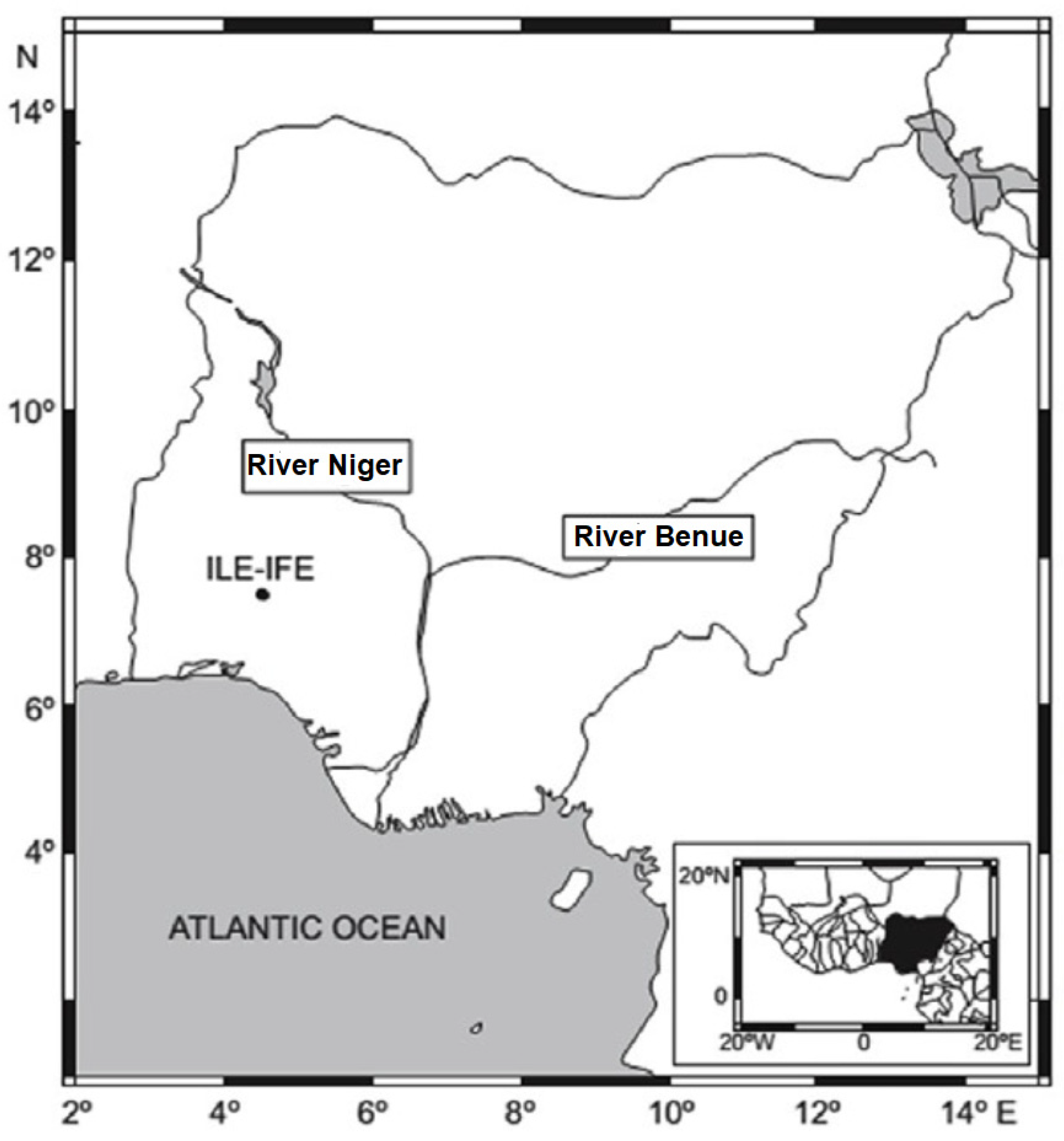


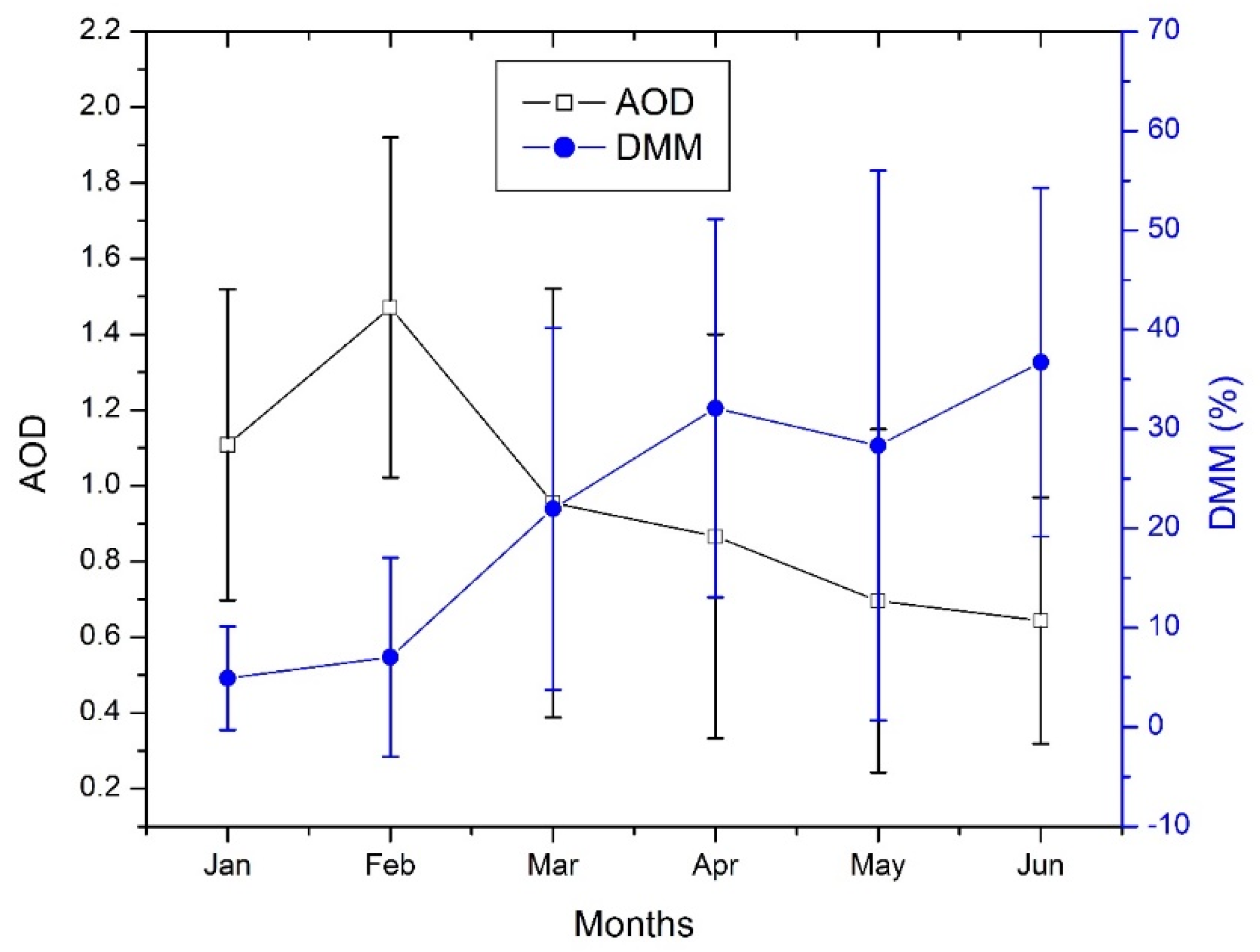

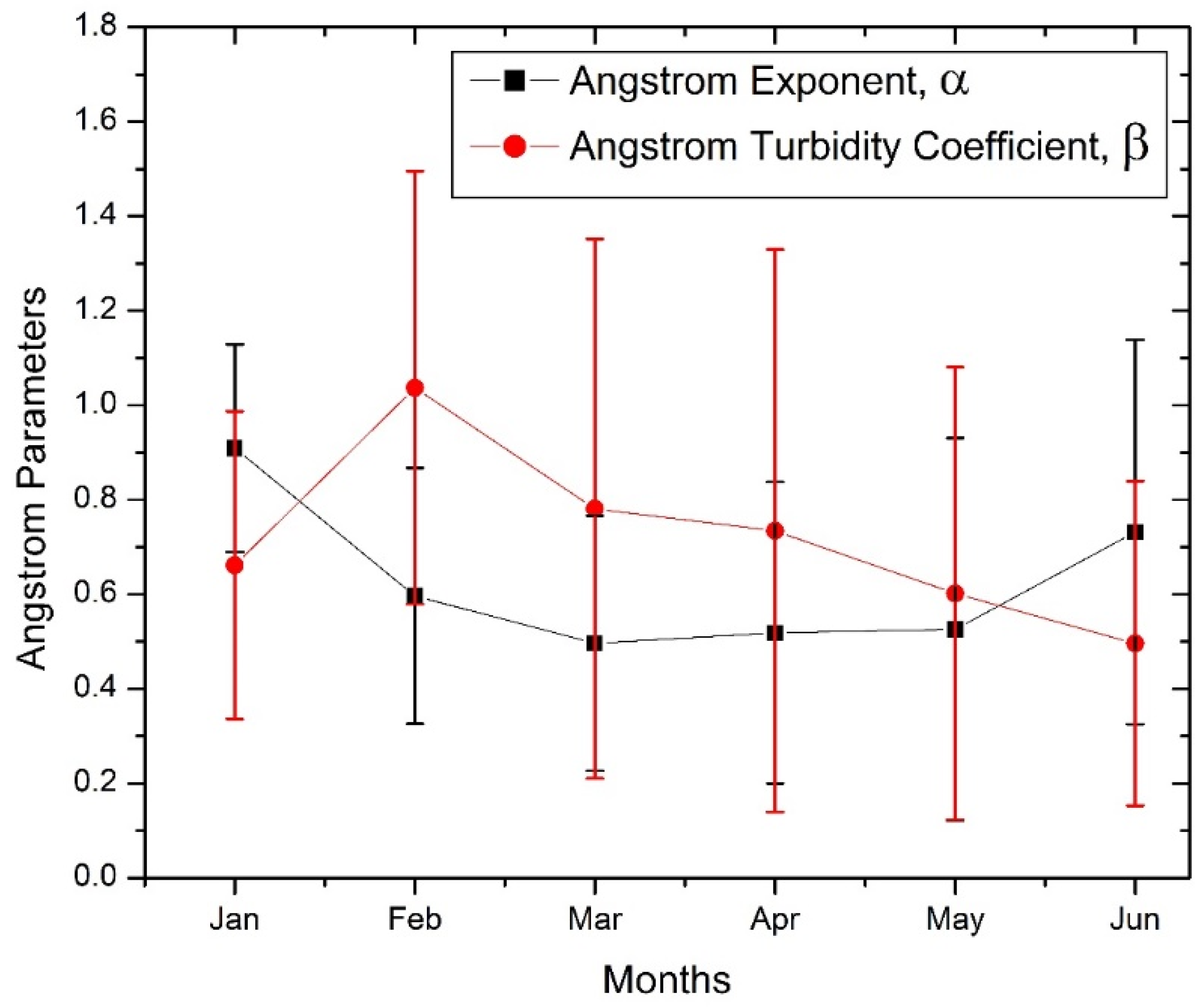
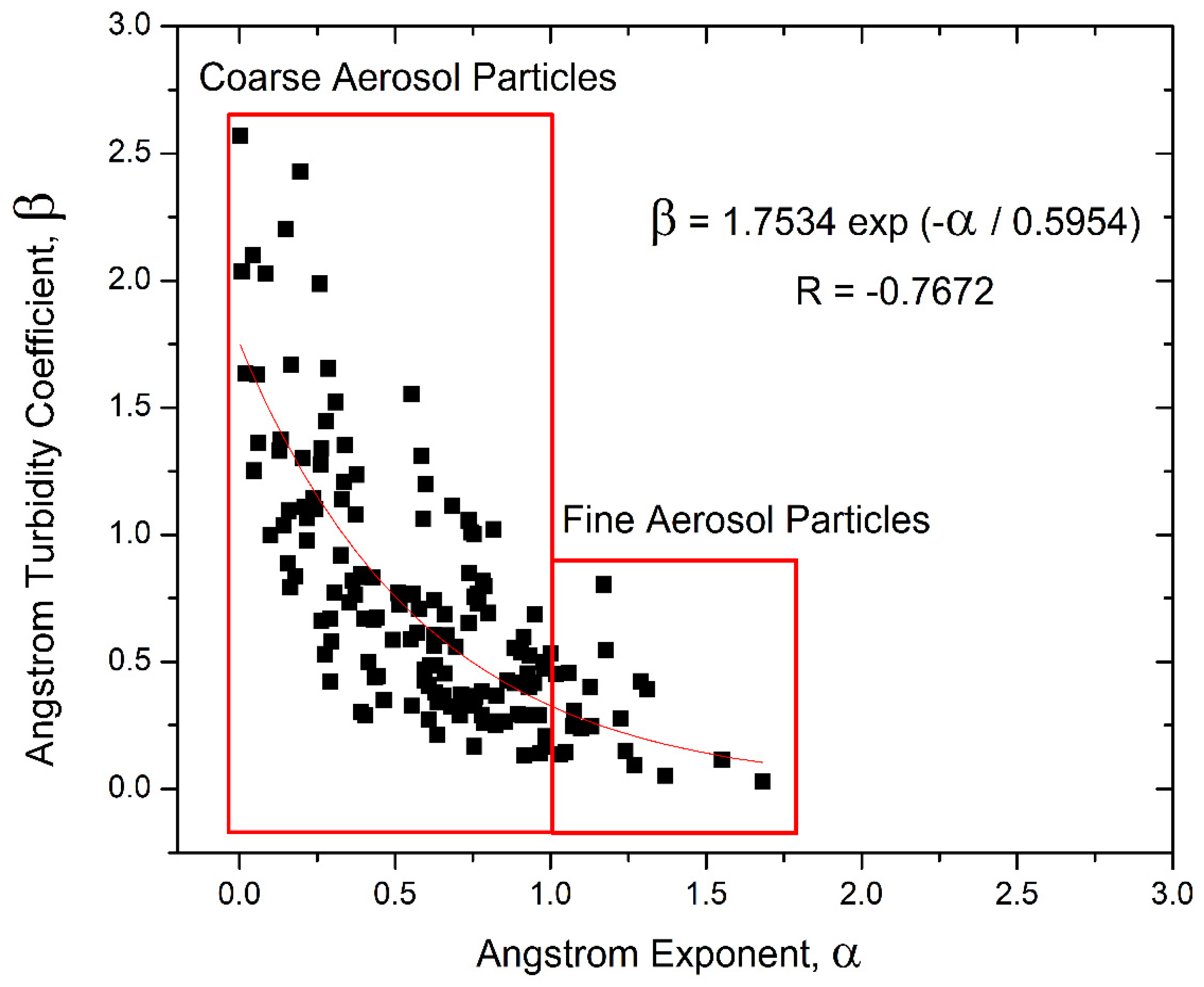
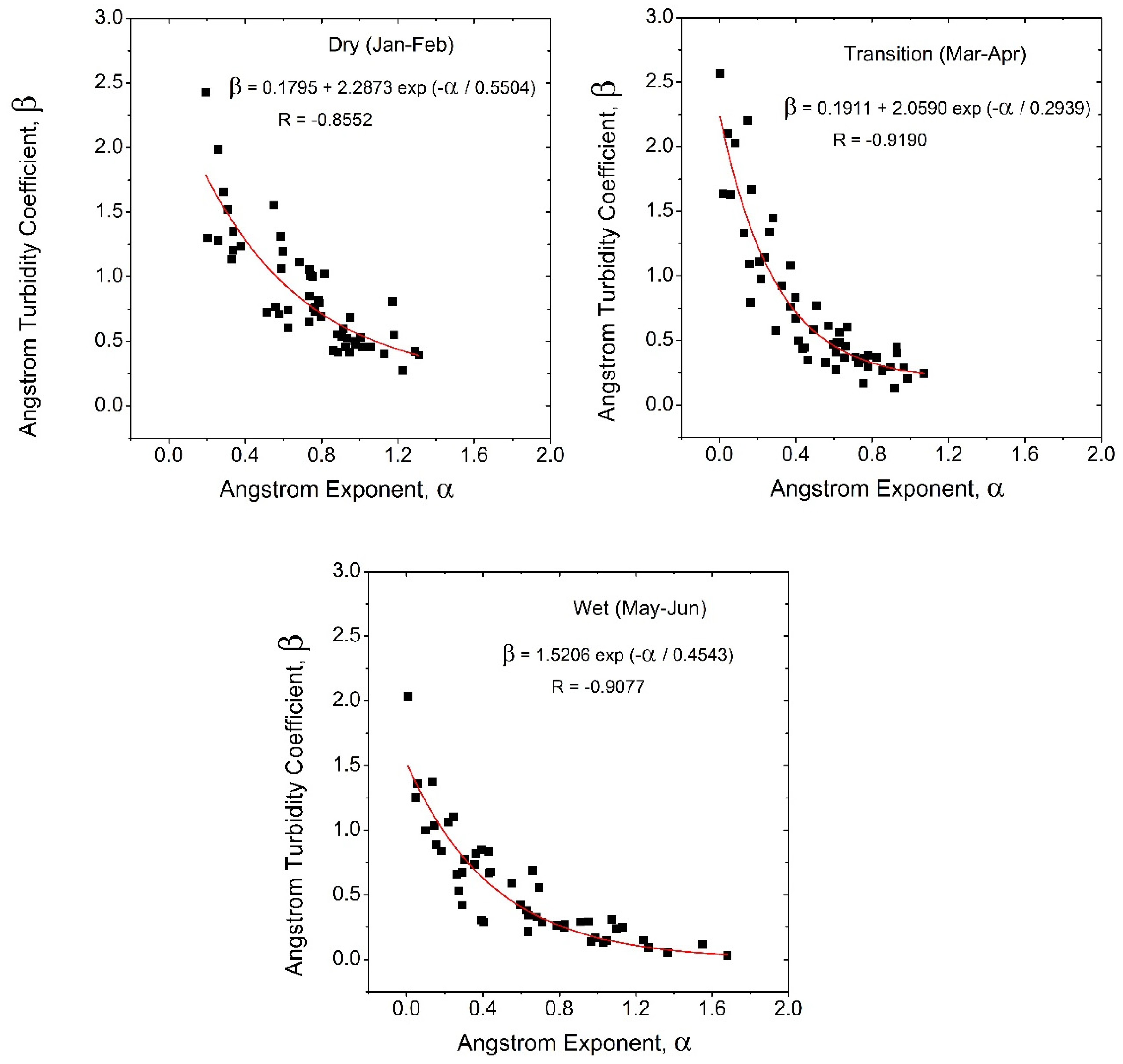
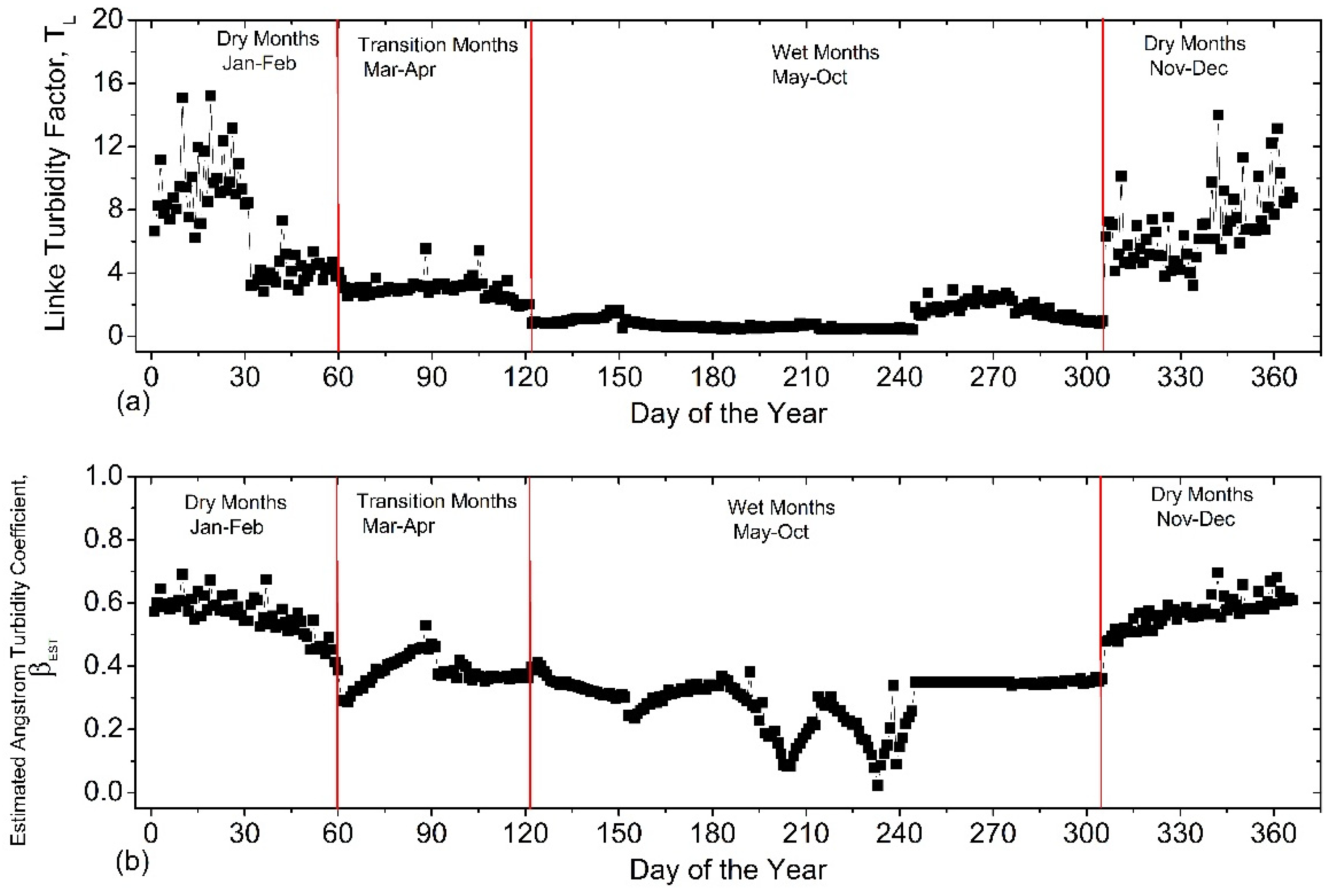
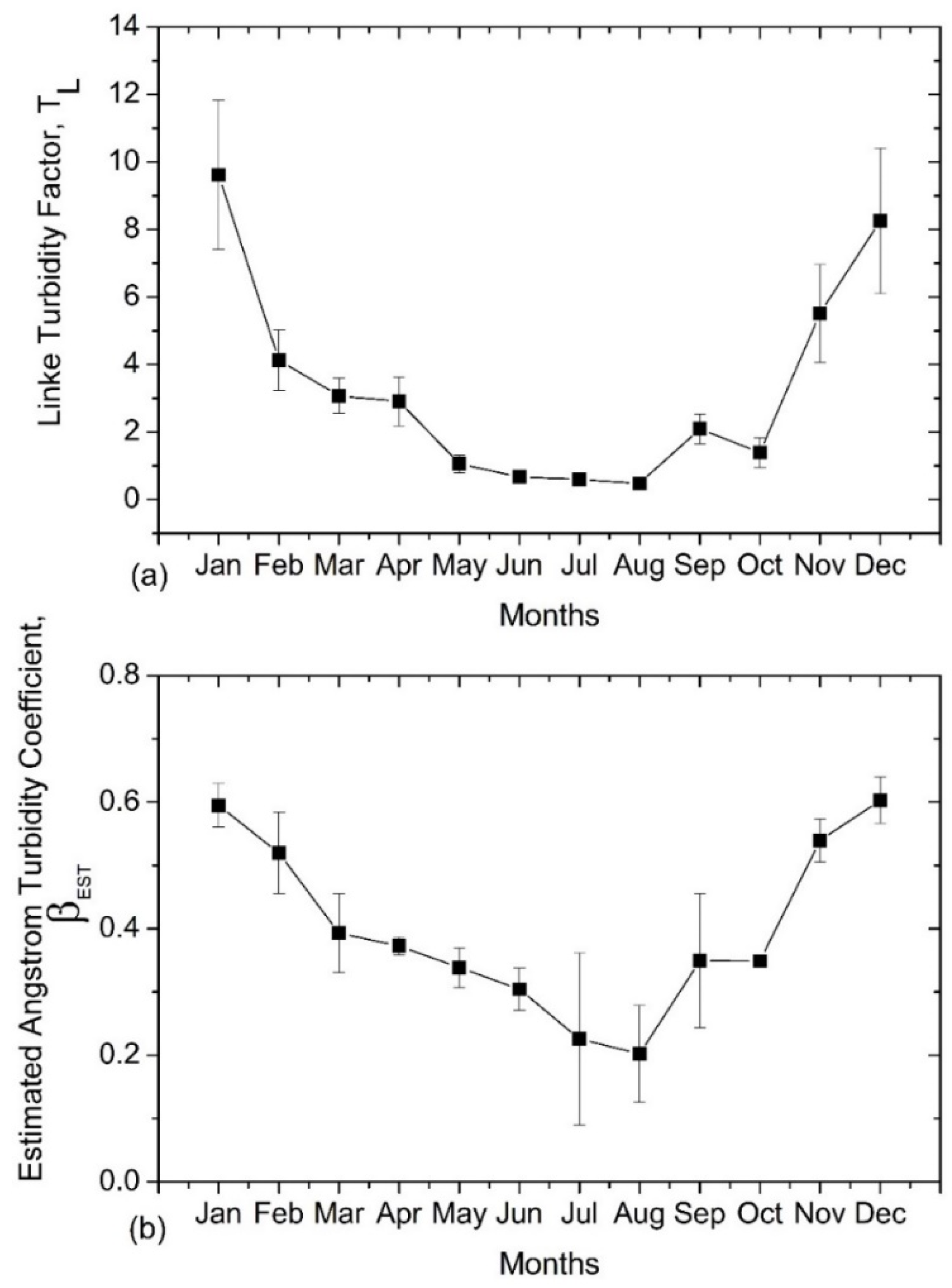
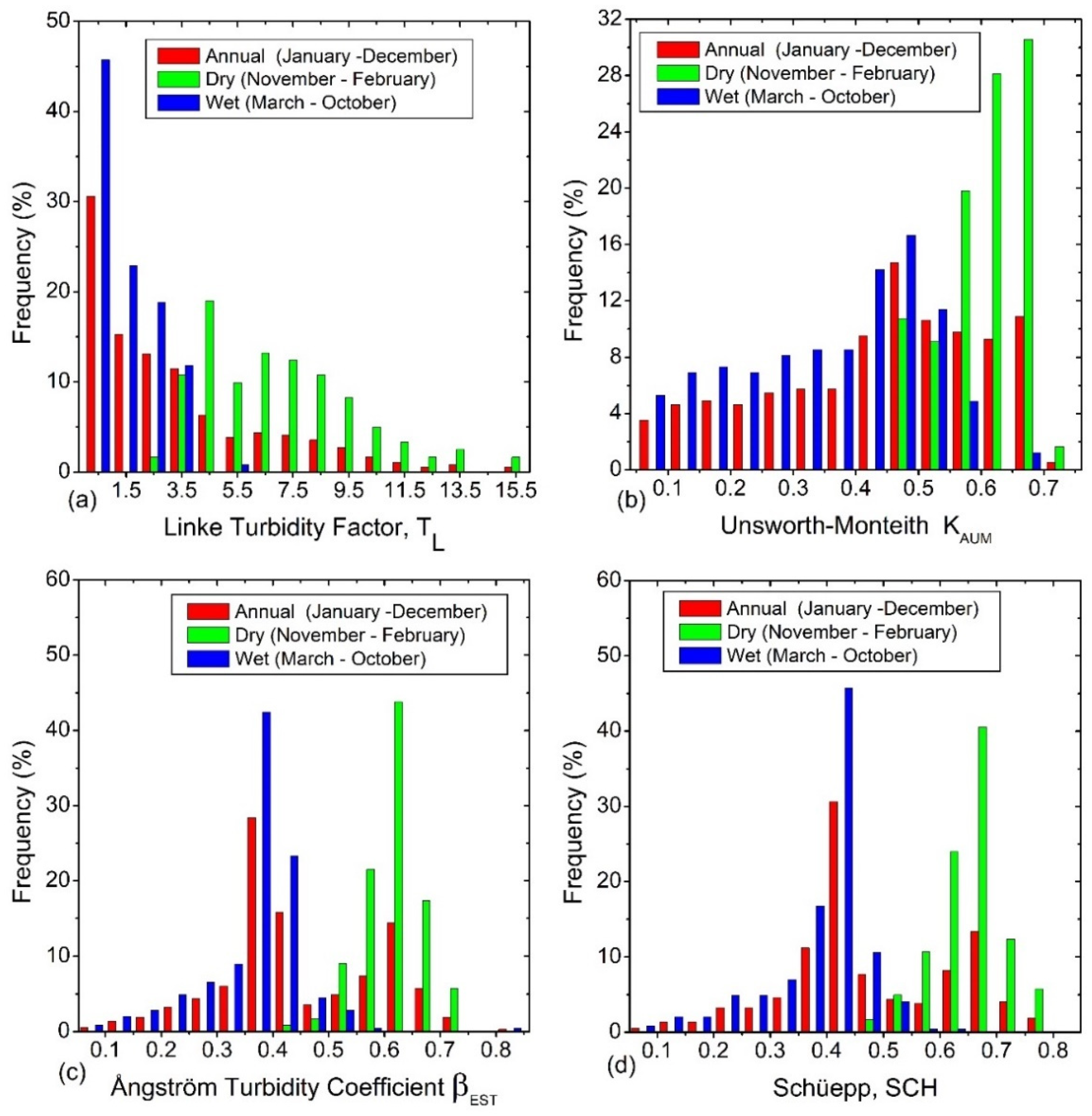
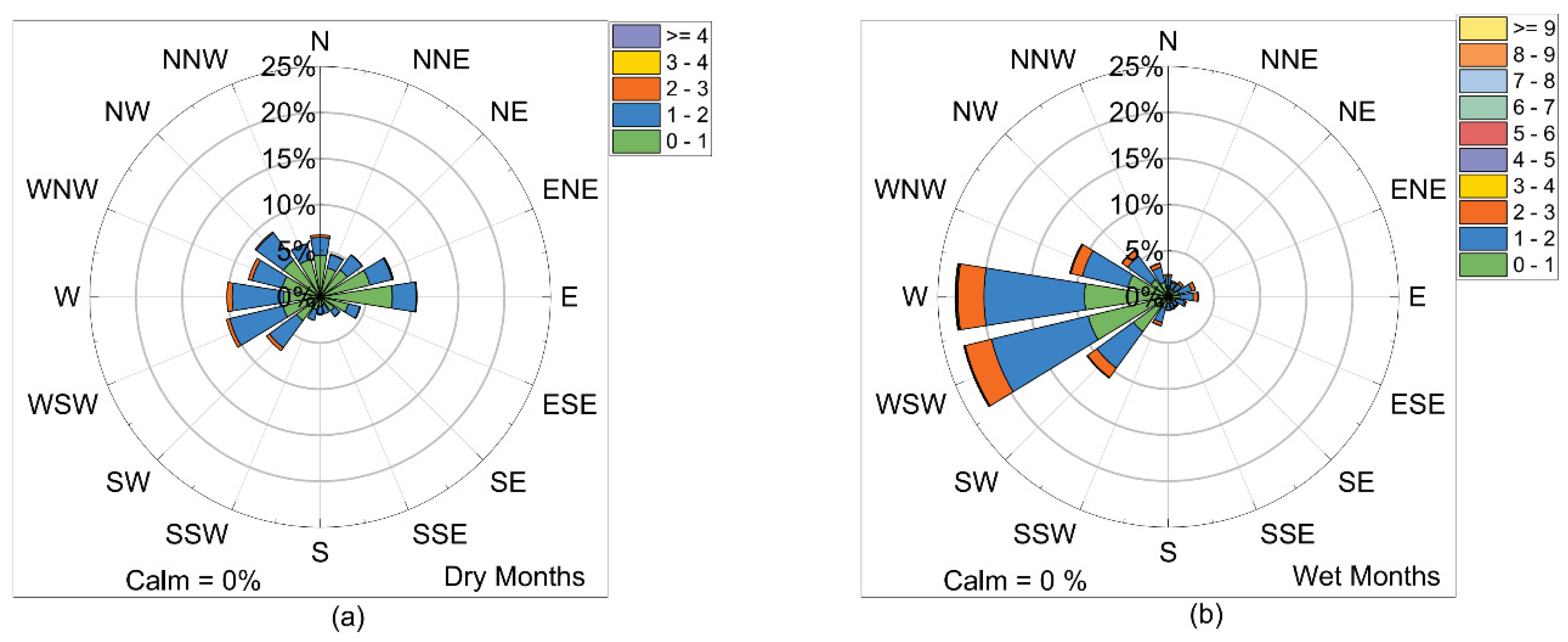

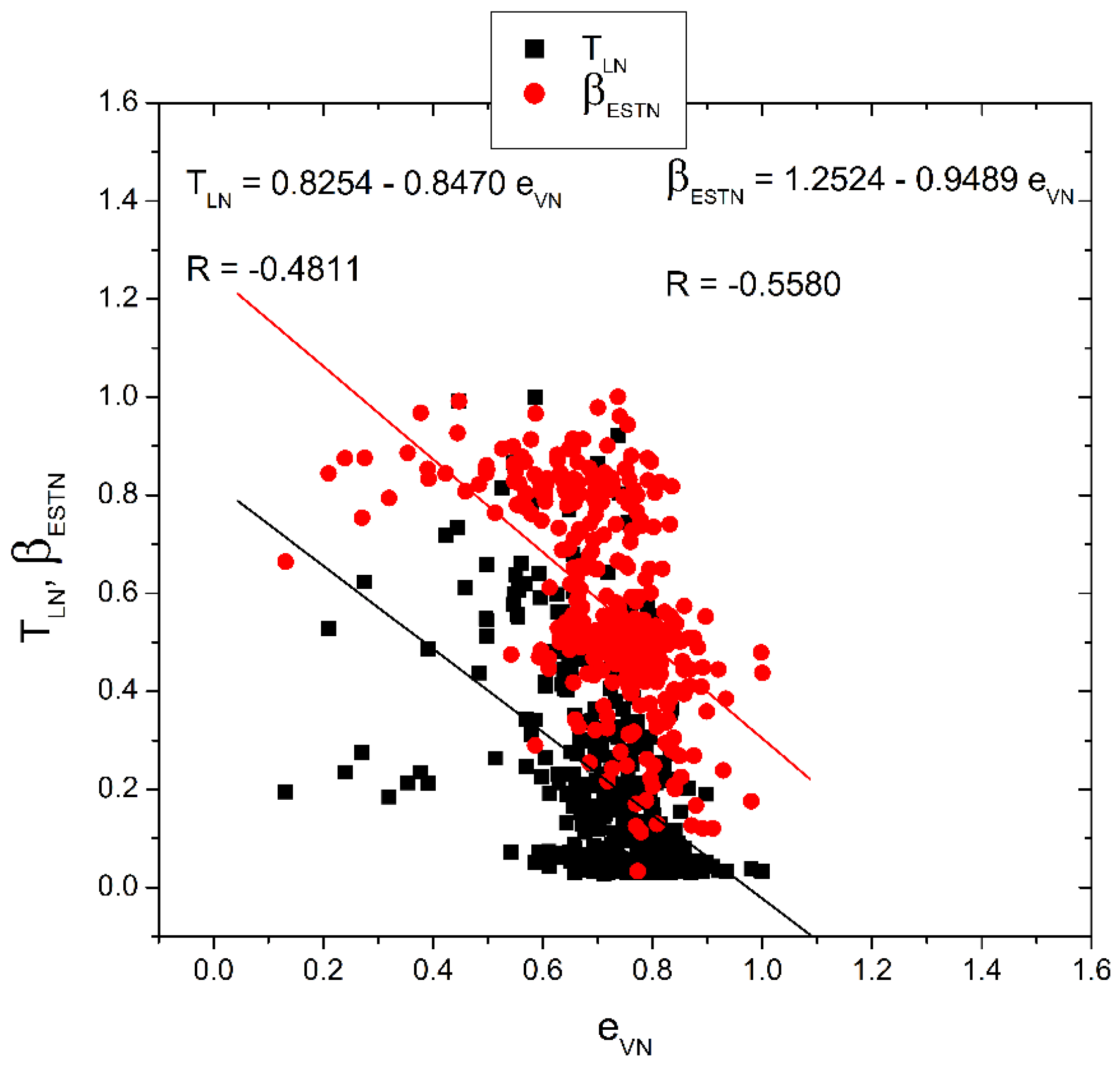

Disclaimer/Publisher’s Note: The statements, opinions and data contained in all publications are solely those of the individual author(s) and contributor(s) and not of MDPI and/or the editor(s). MDPI and/or the editor(s) disclaim responsibility for any injury to people or property resulting from any ideas, methods, instructions or products referred to in the content. |
© 2024 by the authors. Licensee MDPI, Basel, Switzerland. This article is an open access article distributed under the terms and conditions of the Creative Commons Attribution (CC BY) license (https://creativecommons.org/licenses/by/4.0/).
Share and Cite
SoneyeArogundade, O.O.; Rappenglück, B. The Variation in Atmospheric Turbidity over a Tropical Site in Nigeria and Its Relation to Climate Drivers. Atmosphere 2024, 15, 367. https://doi.org/10.3390/atmos15030367
SoneyeArogundade OO, Rappenglück B. The Variation in Atmospheric Turbidity over a Tropical Site in Nigeria and Its Relation to Climate Drivers. Atmosphere. 2024; 15(3):367. https://doi.org/10.3390/atmos15030367
Chicago/Turabian StyleSoneyeArogundade, Olanrewaju Olukemi, and Bernhard Rappenglück. 2024. "The Variation in Atmospheric Turbidity over a Tropical Site in Nigeria and Its Relation to Climate Drivers" Atmosphere 15, no. 3: 367. https://doi.org/10.3390/atmos15030367
APA StyleSoneyeArogundade, O. O., & Rappenglück, B. (2024). The Variation in Atmospheric Turbidity over a Tropical Site in Nigeria and Its Relation to Climate Drivers. Atmosphere, 15(3), 367. https://doi.org/10.3390/atmos15030367





